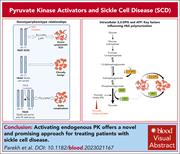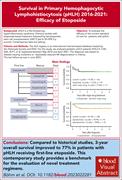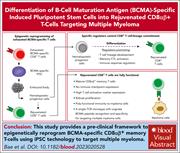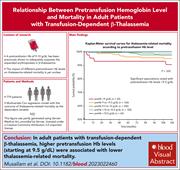Issue Archive
Table of Contents
BLOOD COMMENTARIES
PLENARY PAPER
Nucleic acid sensing promotes inflammatory monocyte migration through biased coagulation factor VIIa signaling
Severe infections activate both inflammatory and coagulation pathways, which may culminate in life-threatening thrombo-inflammation. Design of interventions to minimize these sequelae requires knowledge of how these pathways intersect in tissues in vivo. In this Plenary Paper, Zelaya and colleagues show that macrophage infiltration into the lungs in a model of viral infection is mediated through biased signaling of protease activated receptor 2 initiated by factor VIIa (FVIIa) in complex with tissue factor (TF). These novel data suggest that interventions that target TF-FVIIa should reduce pulmonary thrombo-inflammation triggered by viral infection, and the authors’ approach provides a template for elucidating how coagulation factors mediate specific signaling in other diseases affecting other tissues.
PERSPECTIVE
Arterio-occlusive events among patients with chronic myeloid leukemia on tyrosine kinase inhibitors
The life expectancy of patients diagnosed with chronic myeloid leukemia and treated with tyrosine kinase inhibitors is now similar to that of their age-matched peers. All treatments come at a cost, and Veltmaat and Cortes provide this insightful Perspective that examines 1 class-related toxicity: arterio-occlusive events. The authors highlight the unfortunate deficiencies in trial design and follow-up that delayed widespread recognition of this issue and suggest a framework for standardizing reporting of these events in clinical studies.
BLOOD SPOTLIGHT
Recent developments in the use of pyruvate kinase activators as a new approach for treating sickle cell disease
Red blood cells depend on glycolysis for all energy-dependent activity. In this Blood Spotlight, Parekh and colleagues summarize the data underpinning the emergence of a new class of drugs, pyruvate kinase (PK) activators, as potential therapeutic options for blood diseases other than PK deficiency. The authors review the pathophysiologic basis for their use in sickle cell disease, as well as the clinical data of PK activators currently under phase 3 investigation.
CLINICAL TRIALS AND OBSERVATIONS
Survival in primary hemophagocytic lymphohistiocytosis, 2016 to 2021: etoposide is better than its reputation
Clinical Trials & Observations
Hemophagocytic lymphohistiocytosis (HLH) is a syndrome initiated by common infectious, autoimmune, or malignant triggers, and standard frontline etoposide-based regimens are being challenged as the standard of care by novel agents. Böhm and colleagues provide contemporary real-world data on the use of etoposide for frontline therapy for pediatric patients with primary HLH. The improved outcomes reported in this retrospective study relative to much earlier trials provide a new benchmark against which newer, more expensive treatment regimens should be compared.
HEMATOPOIESIS AND STEM CELLS
IMMUNOBIOLOGY AND IMMUNOTHERAPY
Differentiation of BCMA-specific induced pluripotent stem cells into rejuvenated CD8αβ+ T cells targeting multiple myeloma
In multiple myeloma (MM), T-cell exhaustion is a major barrier to long-term immunotherapy success. Bae et al report on a system where induced pluripotent stem cells can epigenetically reprogram precursor exhausted B-cell maturation antigen (BCMA)–specific cytotoxic T lymphocytes into hematopoietic progenitor cells which, in turn, differentiate into functional BCMA-specific CD8αβ+ memory T cells. In preclinical models, these cells exert an antimyeloma effect. Overall, these studies suggest a potentially tractable path to targeting MM cells via an enduring antitumor immunity-based approach.
TRANSPLANTATION
CSF1R inhibition promotes neuroinflammation and behavioral deficits during graft-versus-host disease in mice
Central nervous system (CNS) chronic graft-versus-host disease (cGVHD) is driven by a unique population of colony-stimulating factor 1 (CSF1)–dependent macrophages that promote late onset CD4+ T-cell– and interferon-gamma (IFN-γ)–mediated neuroinflammation. Adams et al therefore explored the impact of monoclonal antibody blockade of CSF1 receptor in murine models, paradoxically finding that CNS disease increases while systemic cGVHD is reduced. More encouragingly, targeting donor IFN-γ receptor signaling ameliorates CNS cGVHD. These data reveal the compartmentalization of cGVHD pathophysiology.
LETTERS TO BLOOD
Pretransfusion hemoglobin level and mortality in adults with transfusion-dependent β-thalassemia
Clinical Trials & Observations
Regular transfusions have dramatically improved the outcomes for patients with thalassemia major, especially reducing deaths from anemia-related heart failure, but the hemoglobin threshold for maximizing outcomes is the subject of conjecture. Musallam et al report on a retrospective analysis of 10-year survival data in 779 patients, identifying increasing survival to be associated with higher pretransfusion hemoglobin levels, with the highest survival observed when levels were maintained >10.5 g/dL. These data support raising the target threshold for pretransfusion hemoglobin levels in patients with transfusion-dependent thalassemia.
Noncoding mutations drive persistence of a founder preleukemic clone which initiates late relapse in T-ALL
BLOOD WORK
ERRATUM
-
Cover Image
Cover Image
![issue cover]()
Treatment with an anti--colony-stimulating factor 1 receptor-blocking antibody fails to ablate microglia in the brain of a mouse with graft-versus-host disease. The image shows confocal microscopy of brain microglia with IBA1 (red) and major histocompatibility complex II (teal) where double-positive cells appear white; nuclei are stained with DAPI (blue). See the article by Adams et al on page 912.
- PDF Icon Front MatterFront Matter
- PDF Icon Table of ContentsTable of Contents
- PDF Icon Back MatterBack Matter
- PDF Icon Editorial BoardEditorial Board
Advertisement intended for health care professionals
Email alerts
Advertisement intended for health care professionals










PAR2 biased signaling on the move